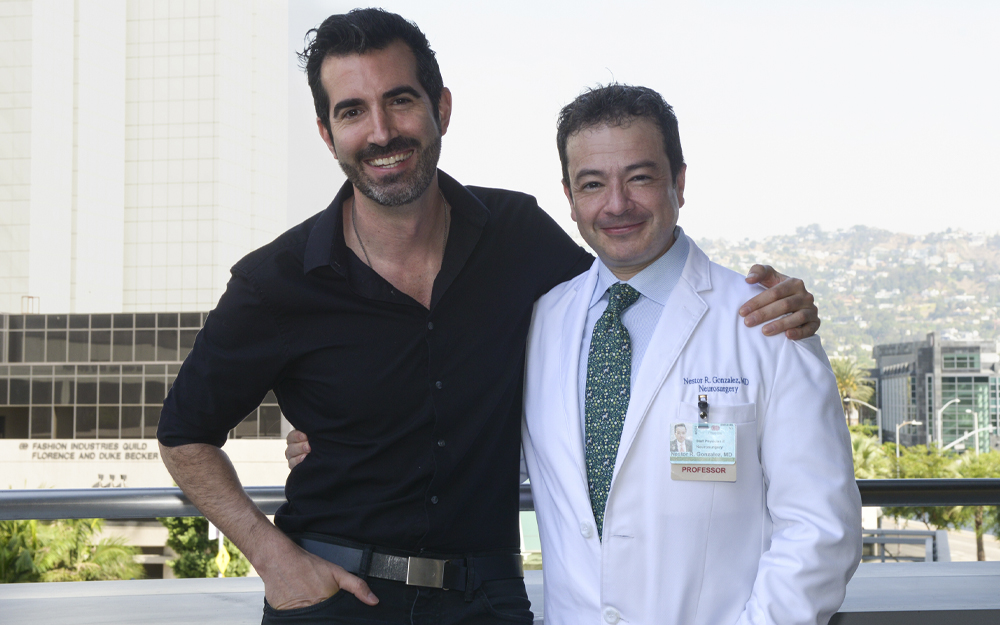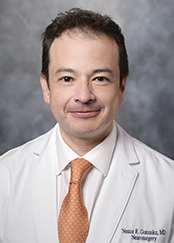Cedars-Sinai Blog
Surviving a Brain Attack
Oct 13, 2017 Cedars-Sinai Staff

Gabriel Goldberg, 44, compares having a stroke to being eaten by a shark. He knew what was happening, but couldn't stop it or guess what part of his body would be attacked next. He says his Cedars-Sinai care team didn't just save his life. "They also saved my quality of life."
"Time is critical. We want to provide the right interventions as soon as possible for the best outcome."
Having a stroke is like being eaten by a shark. You're aware of what's happening, but there's nothing you can do to stop it.
That's how Gabriel Goldberg explains it. The 44-year-old photographer was in the middle of his workout routine when his stroke happened. He was mid-bicep-curl, lifting a 40-pound dumbbell. A sharp, hot pinprick sensation stung his face. Then, he started to feel dizzy and couldn't speak.
"I called a friend of mine, and about a minute later, I couldn't even stand up," he says. "The whole room turned sideways."
Time is brain. It's an expression doctors, nurses and others in the Cedars-Sinai Stroke Program repeat often. It's a race against time from the moment a stroke happens. For the best chance for surviving and preserving quality of life, stroke patients need to be treated within 6 hours.
A stroke is a "brain attack" that can happen to anyone at any time. Ischemic strokes, like the one Goldberg had, happen when a clot cuts off blood flow to the brain. Without blood, the brain is deprived of oxygen, and brain cells begin to die. The damage done by a stroke depends on where it happens in the brain and how much of the brain is damaged.
Goldberg is no stranger to hospitals. He was born with a congenital heart condition that he's managed with a healthy lifestyle, medications and surgeries. He's had 3 open heart surgeries, including a valve replacement when he was 31. None of it was as frightening as having a stroke, he says.
In Discoveries: Surgical Strike Against Stroke
Code Brain

Nestor R. Gonzalez, MD
Paramedics alerted Cedars-Sinai that they were bringing Goldberg in, which triggering a "Code Brain." The team of stroke specialists was in place, ready to start tests and treatment as soon as Goldberg arrived in the Emergency Room.
"I remember there were 7 or 8 doctors and nurses around me, asking me what my name is, who the president is, how old I am," Goldberg says.
He knew he sounded like he had a speech impediment when he answered, as though he couldn't get his brain, mouth and tongue to work together.
"They asked me what my biggest fear was," he says. "I was scared I'd never walk again or speak clearly again. And that I’d never be able to take photos again."
Read: Stroke is Unpredictable
The team quickly determined with a CT scan that Goldberg didn't have a bleed in his brain. They gave him a tissue plasminogen activator, usually called tPA, a clot-busting drug that's given through an IV. This drug is the reason the time factor is so important. When it's given shortly after a stroke, it's effective in dissolving clots and improving blood flow to the brain.
"Time is critical," says Nestor R. Gonzalez, MD, the neurosurgeon who treated Goldberg. "We want to provide the right interventions as soon as possible for the best outcome."
In Goldberg's case, his clot was too large for the drug alone to break it up. Gonzalez performed a surgery called a mechanical thrombectomy. He threaded a catheter into an artery until it reached the clot that caused Goldberg's stroke. Then, guided by imaging, he placed a stent into the blood vessel, stretching it so the blood can flow. The stent was then pulled backward to remove the clot.
"It's extremely difficult," says Laurie Paletz, RN, stroke program coordinator in the Department of Neurology. "It's like threading a needle where the thread keeps turning and circles around itself. It requires advanced neurosurgical training and sophisticated operating skills."
Speaking his name
Three clots in all were pulled from Goldberg's brain.
When he woke up in the Neuro Intensive Care Unit, he was asked again what his name was.
"Gabriel Goldberg," he replied. This time, clearly.
"When I woke up from surgery, I was fine. I could see," he says. "I could speak without any problem, and my voice sounded like me. I could move my entire right side. I was myself, completely, totally, wholly. I walked out of Cedars-Sinai, thanks to Dr. Gonzalez, without any residual side effects from my stroke. I believe the medical term most of the doctors used was I had 'dodged a bullet.'"
He stayed in the hospital for 4 days, and returned to work in 4 weeks.
He says he feels lucky he was so close to Cedars-Sinai when the stroke happened. Nothing he feared has come to pass.
"My work wasn't disrupted, nor did I have to relearn how to walk or talk," he says.
"Dr. Gonzalez and his team didn't just save my life. They saved my quality of life."


